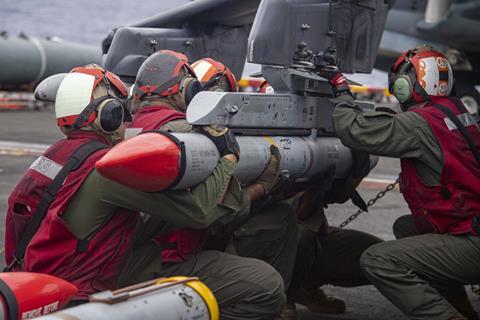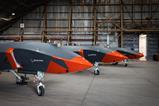Munitions producer Raytheon is working to integrate its venerable AIM-120 advanced medium-range air-to-air missile (AMRAAM) with experimental uncrewed fighter jets being developed by the Pentagon.
The US Air Force (USAF) in April selected autonomy start-up Anduril and uncrewed aircraft designer General Atomics Aeronautical Systems to produce “production representative test articles” of what the service calls Collaborative Combat Aircraft (CCA). These are envisioned as small, low-cost vehicles that could provide a range of combat support functions to conventionally crewed fighter jets.
While kinetic strikes have long been suggested as a possible CCA mission, recent comments by a Raytheon executive mark the first official confirmation from a weapons manufacturer that lethal munitions are being integrated into the new platforms.
“We’ve been working with the air force with their Collaborative Combat Aircraft,” said Jon Norman, vice-president of defence systems requirements with Raytheon, on 10 September.
Norman made the remarks during an event with Raytheon parent company RTX discussing modernisation initiatives for the Lockheed Martin F-22 fighter.

The CCA reveal came as Norman discussed future plans for Raytheon’s widely-used AIM-120 AMRAAM, which he says is in service in 43 countries across 14 different fighter platforms, as well as ground-based air defences.
“They’re integrating that onto Block 1,” he reveals, referencing the inaugural tranche of CCA designs being worked on by Anduril and General Atomics.
A subsequent round of CCA development is in the works, with requirements for those Block 2 vehicles still being developed at the Pentagon.
The AMRAAM was selected by the air force as a “threshold weapon” for the initial CCA designs, Norman says, as the service works out exactly how it plans to use the autonomous support jets.
Once concept is for CCAs to act as essentially an airborne missile reserve for stealthy manned fighters like the Lockheed F-35 and F-22 – what Norman calls an “air-to-air truck”.

“It’s a force extender, so they have more munitions available,” he suggests.
While both fighters have the ability to carry their own guided missiles, the internal weapons bays required for maximum stealthiness have a capacity that is more limited than jets using traditional wing-mounted hardpoints.
“With the Collaborative Combat Aircraft, now it has a platform out there that’s in the right position, survivable and it can employ AMRAAMs, guided and directed by that F-35 or by the F-22,” Norman says.
In addition to flight range and anti-jamming improvements developed for the latest AIM-120D-3 AMRAAM variant, Norman says CCA integration is part of Raytheon’s effort to “future proof” the long-serving air-to-air missile.
A former Lockheed F-16 pilot with the USAF, he notes the beyond-visual-range weapon is drastically improved from the version he carried as an aviator.
“This missile is completely different than when I first started flying with it,” Norman says.
Improvements to the onboard processors and guidance system have extended the range of the latest AMRAAM by employing a more efficient flight profile after the missile has been launched.
Combined with increased resistance to enemy radar jamming and electronic countermeasures, the result is “significantly increasing the probability of kill”, Norman says.
Those improved munitions could see frontline service aboard the first CCAs by the end of this decade, when the USAF hopes to field a fully operational capability.
The service has said it expects to make a competitive production decision for the first increment of CCAs in fiscal year 2026, with the goal of eventually delivering at least 1,000 of the autonomous aircraft.
















































